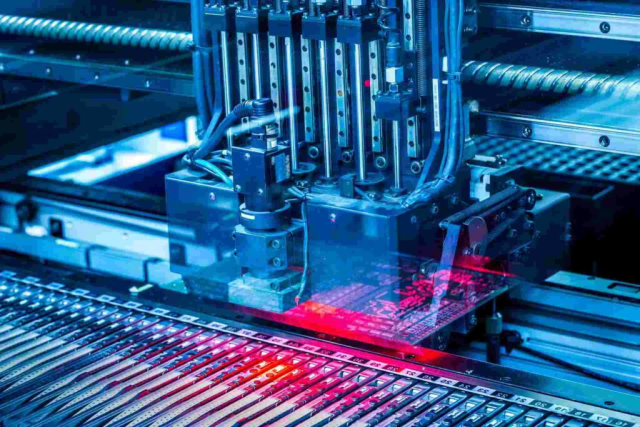Why Cavity Resonance Is the Hidden Enemy in High-Dk RF Boards
In high-frequency RF front-end modules—especially those operating beyond 20 GHz—engineers often encounter unexpected resonance spikes, gain ripple, and phase drift despite ideal simulations.
The culprit is frequently cavity resonance—localized standing waves caused by dielectric thickness, copper enclosure geometry, or high-Dk material behavior.
Rogers Duroid 6010, with its high dielectric constant (Dk ≈ 10.2), enables compact miniaturized designs but also increases electromagnetic field confinement. Without careful cavity management, this can lead to mode coupling, insertion-loss increase, and signal phase distortion in critical radar and transceiver boards.
KKPCB engineers have developed a signal-integrity-driven design and verification workflow that mitigates these resonance issues through hybrid material tuning, copper geometry control, and EM-field calibration.

Understanding the Challenge — High-Dk Means High Sensitivity
| Issue | Root Cause | Impact on RF Performance |
|---|---|---|
| Resonance Peaks at ~24 GHz | Board thickness × dielectric Dk ≈ λ/2 | Spurious reflection, ripple in S21 |
| Phase Imbalance in Differential Paths | Uneven copper plane height | Skew & mismatch in baluns |
| Impedance Drift under Thermal Load | Dk shift (+1 %) @ 125 °C | Return loss degradation |
| EM Field Coupling to Shield Cavity | Incomplete grounding or voids | Radiated EMI, gain drop |
Duroid 6010’s ceramic-PTFE composition provides low loss (Df = 0.0023 @ 10 GHz), but the field confinement effect at higher Dk values requires specialized layout and process adjustments to preserve consistent impedance and minimize parasitic modes.
KKPCB’s Engineering Framework for Resonance-Free Duroid 6010 Designs
1. Cavity Mode Prediction and Simulation
-
3D full-wave EM modeling (Ansys HFSS, Keysight EMPro) identifies standing-wave distributions across metal cavities.
-
Eigenmode analysis quantifies resonance Q-factor to guide ground-via placement.
2.Stackup Optimization for Mode Suppression
-
Hybrid layering: Duroid 6010 (0.254 mm) + RO4003C prepreg balances Dk gradient.
-
Controlled ground-via grid (≤ 1.5 mm pitch) to short unwanted cavity modes.
-
Symmetrical copper balancing reduces Z-axis deformation during lamination.
3.Lamination and Bonding Control
-
Vacuum lamination with 200 psi pressure at 180 °C to prevent voids.
-
Copper roughness Ra < 0.8 µm ensures minimal EM scattering.
-
Core-to-core misalignment < 50 µm maintains dielectric uniformity.
4.RF Validation and Cavity Scanning
-
Post-process cavity resonance mapping using VNA S11/S21 sweep (10–50 GHz).
-
Inline Time Domain Reflectometry (TDR) verifies controlled impedance within ± 5 %.
Case Study — X-Band RF Front-End Module for Synthetic Aperture Radar (SAR)
Client: European aerospace electronics OEM
Objective: Design a compact 10 GHz SAR front-end with minimal cavity resonance and stable insertion loss across temperature extremes.
Design Parameters:
-
Frequency: 9.8–10.2 GHz (X-band)
-
Material: Duroid 6010 (0.254 mm core) + RO4003C (0.2 mm bond ply)
-
Impedance: 50 Ω microstrip, ± 5 % tolerance
-
Thermal Profile: –55 °C ↔ +150 °C
-
Finite-element resonance scan to map mode energy peaks.
-
Via stitch grid re-patterned (1.2 mm pitch → 0.8 mm pitch).
-
Inner-layer ground segmentation reduced floating modes.
-
Lamination controlled for uniform dielectric thickness (± 7 µm).
Results:
| Parameter | Before Optimization | After KKPCB Process |
|---|---|---|
| Cavity Mode Peak (23.8 GHz) | –16 dB return loss | < –29 dB (fully suppressed) |
| Insertion Loss (S21) | 0.38 dB/inch | 0.27 dB/inch |
| Phase Skew Across Channels | 2.4° | 0.7° |
| Impedance Stability (Thermal Cycle 1000×) | ± 8 % | ± 3.5 % |
Outcome:
The radar front-end module passed MIL-PRF-31032 thermal shock tests with no resonance peaks up to 40 GHz, achieving stable gain and phase response even after 1000 thermal cycles.

Engineering Insights — Managing Signal Integrity Beyond Geometry
-
Hybrid Stackups mitigate Dk contrast and reduce field density hotspots.
-
Microvia back-drilling removes stub resonances above 20 GHz.
-
Differential pair length matching < 50 µm ensures uniform phase propagation.
-
Conformal EMI shields with 0.1 mm gap prevent standing-wave reflection between PCB and cover.
KKPCB integrates these principles into a closed-loop design–test workflow, correlating EM simulation results with measured S-parameters to eliminate resonance uncertainty during prototyping.
Environmental and Reliability Validation
To guarantee field reliability, each Duroid 6010 RF board undergoes:
| Test | Condition | Result |
|---|---|---|
| Thermal Shock | –55 °C ↔ +150 °C / 1000 cycles | No delamination, no impedance shift |
| Humidity Endurance | 85 °C / 85 % RH / 1000 h | Df variation < 0.0003 |
| RF Power Load | +10 dBm continuous wave / 48 h | S21 stability ± 0.05 dB |
| Resonance Drift | 10–40 GHz VNA Sweep / Thermal Stress | Peak shift < 0.2 GHz |
These results validate that Duroid 6010 substrates, when processed under KKPCB’s controlled lamination and via-ground architecture, can sustain stable RF performance in high-field, high-Dk environments.
KKPCB Quality and Process Assurance
-
Dk/Df Characterization at 25 °C and 125 °C for each batch.
-
Lamination and via structure traceability via digital lot records.
-
Inline RF testing (S21/S11) up to 110 GHz.
-
Accelerated thermal aging tests to predict field drift.
-
Statistical process control (SPC) for impedance consistency.
KKPCB’s approach integrates material science and RF engineering into a unified manufacturing logic, ensuring that high-Dk Duroid 6010 boards meet the exacting demands of aerospace, radar, and 5G front-end applications.
Conclusion — Precision Without Resonance
Through precise cavity modeling, hybrid stackup design, and rigorous validation, KKPCB engineers deliver Duroid 6010 PCBs with exceptional signal integrity and resonance-free performance across mmWave and X-band frequencies.
-
Cavity-resonance-free Duroid 6010 PCB stackups (10–40 GHz)
-
RF front-end design co-engineering and impedance tuning
-
Full thermal and environmental reliability certification
Contact KKPCB Engineering to optimize your Duroid 6010 RF module designs and validate signal integrity under mission-critical conditions.

